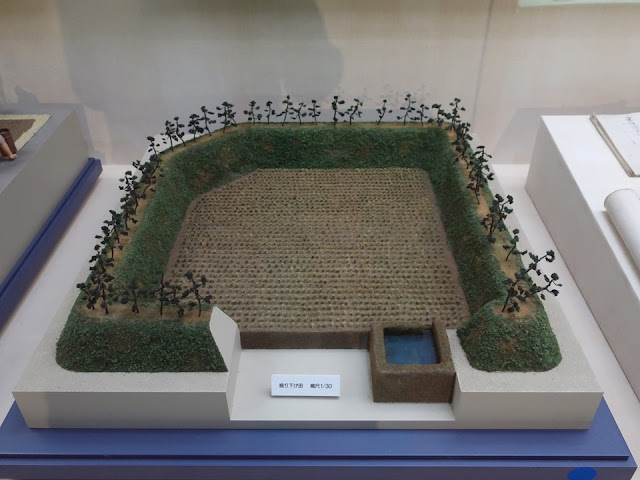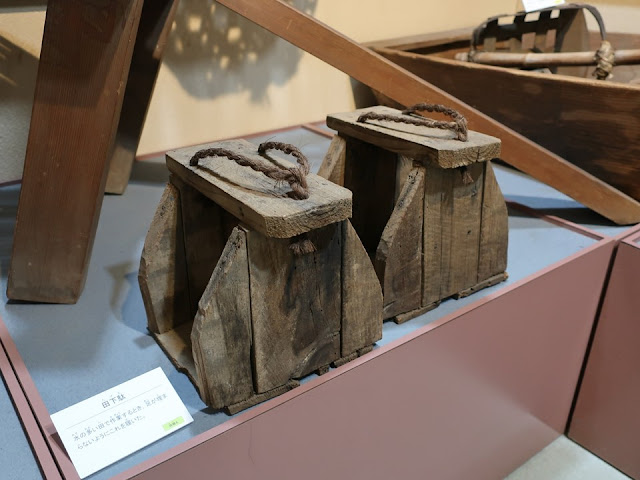Kamisu is around 100km east of Tokyo.
It is located at the estuary of Tone River which is the second longest one. There
is Ikisu Shrine where many visitors came by boat in the Edo period (1603~1868).
It flourishes as one of the largest industrial zones now.
Kamisu faces the river and the ocean,
moreover there was a big lake. People suffered from floods, but simultaneously
received the bounty of the water. Their livelihood was both farming and fishing.
We can understand the fun of ordinary people in the past mainly at the folklore
exhibition room.
We need to get an approval to take pictures.
茨城県神栖は、利根川の河口にあります。息栖神社の門前であり、江戸時代は、多くの参詣者が舟で訪れ賑わったようです。今は、日本有数の工業地帯になっています。
また、川、海、湖(神之池/ごうのいけ)があり、水の恵みと害を受けながら、人々は半農半漁の暮らしを営んでいました。民俗の展示では、少し昔の人々の楽しみわかります。
許可を得て撮影しました。
Permanent exhibition room、常設展示室
The local history is shown mainly. There are two city models in center; at present and around 1885.
主に歴史の展示です。中央に、現在と1885年頃の市の模型があります。
There were people called Kai(sea)-fu(men) in the medieval era. They were engaged in fishing and water transportation. They offered seafood to Kajima Shrine and Katori Shrine, so those shrines guaranteed their businesses instead. I guess they had their particular fun which was suitable to the name “Kai-fu”.
中世に海夫(かいふ)という海の民が生活していました。鹿島神宮、香取神宮の下で、供物として魚介を奉納することで、制約を受けずに漁業を営み、水上輸送にも携わったそうです。
わざわざ「海夫」と名付けられていますので、きっと、農民とは違う楽しみを持っていたと思います。
The land is at the coast, so they struggled to make new rice fields in a sand dune. They dug, planted windbreak and built a reservoir. It was a big effort.
水に囲まれた土地なので、苦労して新田開発を続けました。砂丘の低湿地には、砂防林と溜め池を備えた「掘り下げ田」を作りました。大変な労力です。
On the other hands, fishery went well. When a school of sardines appeared, fishermen went netting. All villagers went to the beach and pulled the net. At first, sardines were boiled and oil was extracted. Afterward, they were pressed, dried and sold as fertilizers. Farmers in my area bought dried sardines at that time. I’m sure people delighted when they found sardines.
一方、水は様々な恵みを与えてくれました。鰯の群れが見つかると舟を出して網を張り、村人が総出で網を引きます。捕れた鰯は、煮てから油を絞り、カスは肥料として売ります。製造工程が展示されています。鰯が見つかったら大喜びですね。我が家の近くの農家も干鰯を買った記録を残しています。
Ikisu Shrine、息栖神社
The photo above is a model of the shrine and the town in the Edo period. The guardian deities of the marine traffic are enshrined.
The ferry was busy with visitors and transportations, and there were tea houses. Famous writers and artists such as Bashou Matsuo (poet) also visited and created works.
息栖神社と河岸の模型(江戸時代)。息栖神社は、岐神(くなどのかみ)を主神とし、天鳥船神と住吉三神が祀られた海上守護の神様です。
参詣の人々や物資の積み卸しで、茶屋などが建ち大変な賑わいでした。松尾芭蕉、小林一茶、十返舎一九など文人墨客も訪れています。
Travel goods and the picture of the town in the old guidebook (published in 1823).
旅の道具と鹿島名所図会(1823)に描かれた息栖神社
The petition about an attempted murder in 1679 is preserved; the boatman was injured by the passengers on the ferry which linked Kamisu and Kioroshi which is in the upper course of the river. Thereafter, each passenger’s name and address, plus the boatman’s name were recorded. Those were efforts to keep a safe and enjoyable trip.
利根川上流の木下と神栖を結ぶ木下茶舟の船頭が乗客に殺されかけた事件の訴状(1679年、上)が残っています。以降、乗客の住所氏名、船頭の名前を記録するようになったそうです。また、船頭の身元を示す手形(1691年)もあります。楽しい舟旅を担保するための仕組みですね。
The main hall is not so large. The giant sakura cherry tree on the left started blooming when I visited in the mid-March.
ご本殿はそんなに大きくありません。本殿の手前に桜の巨木があり、花がほころび始めていました。
These are lifting stones called “Chikara (power) Ishi (stone)”. Lads competed for the power during festivals or rest time in the summer evening. Shigezou who was a gangster of chivalry offered a stone which is around 190 kg.
祭や夕涼みなどで集まった若者達の力比べに使われた力石。対岸にいた侠客・笹川の繁蔵が奉納した50貫余(約190kg)の力石もあります。
Kashima industrial zone is being developed. Hundreds of companies have factories here. I went there by business trip.
神栖では、鹿島臨海工業地帯の開発が行われ、今では数百社が集積する日本有数のコンビナートになっています。私も仕事で参りました。
Folklore exhibition room、民俗展示室
Tools of everyday lives are exhibited which were used before Kashima industrial zone was built (mid 1950’s).
The photos on the panel which explained the room are attractive. The elderly people formally dressed and sat down on the cart. We can understand the lives back then well.
鹿島工業団地の開発前、1950年代半ばまでの暮らしの道具が展示されています。
全体の説明パネルの写真が素敵でした。敬老会の写真にビックリ。正装で正座です。
Nursery activity at a rice nursery; it was fun for the child to get on a swaying tub, I think.
苗代での子育て。ワイルドですが、タライがいい感じに揺れて子どもは楽しいでしょう。
After the big catch, the ship owner presents gorgeous clothes “Maiwai” to crews. The dolls, which are around 10cm tall, wear same ones. They pray for a big catch every day.
大漁の祝いに船方が船子に贈る晴れ着「万祝(まいわい)」を着た高さ10cmほどの人形。願いは一攫千金。
Catching shijimi clams seems to be a plain work, but it must be stable. There is a fisherman’s shop in front of Ikisu Shrine. It is a long-standing business.
シジミ漁は地味だけど、手堅そう。息栖神社の船着き場跡にシジミの直売所がありました。今も続く仕事ですね。
This classification table of traditional fishing methods is very understandable.
すごく分かりやすい漁法の分類です。
Tools for living、生活の道具
“Shima-dai” tray is set behind; the radish crane and the pumpkin turtle are on the grain of rice. Pine, bamboo and plum trees are set in the most behind. Those are icons of fortune in Japan. The tray is served at happy events such as a festival. It seems to be also used at the party that a newborn baby is transferred from the wife’s parents’ house where the baby was born to the husband’s house.
奥に置かれているのが「島台(しまだい)」です。米を盛って、松竹梅を配し、大根で作った鶴とカボチャで作った亀を乗せます。祭などのおめでたい行事で出されます。孫渡し(妻の実家で生まれた子を婚家に渡す行事)でも作られるようですよ。
Amimoto (the head of fishermen) house、網元の家
It is designated as a national cultural asset, and its model is shown at the museum entrance. I thought a fisherman’s house is rustier than a farmer’s one, but this is luxurious.
エントランスにある山本家の模型。漁家として国指定重要文化財になっているのは数例だそうです。漁村の家は粗末な感じがしていましたが、山本家は異なります。公開はしていないようでした。
The life in Kamisu would be varied because of rich
natural environment; Tone River, Pacific Ocean, Kounoike Lake and plain lands. People
have kept the strong bond to live and enjoy days there, I reckon.
河口でしかも大きな池があった神栖の暮らしは、変化に富んでいたと思います。いろいろなことが起こったはずなので、地域の人達の繋がりはきっと強かったと思います。
Visited in March, 2020
Official
website: https://www.city.kamisu.ibaraki.jp/kanko_sports/culture/1002541/1005352.html
(in Japanese), accessed in March, 2021
Previous post (National museum near there):
National Museum of Japanese History(3/3)、国立歴史民俗博物館 (3/3)
Next post (Local
museum near there):

























Comments
Post a Comment